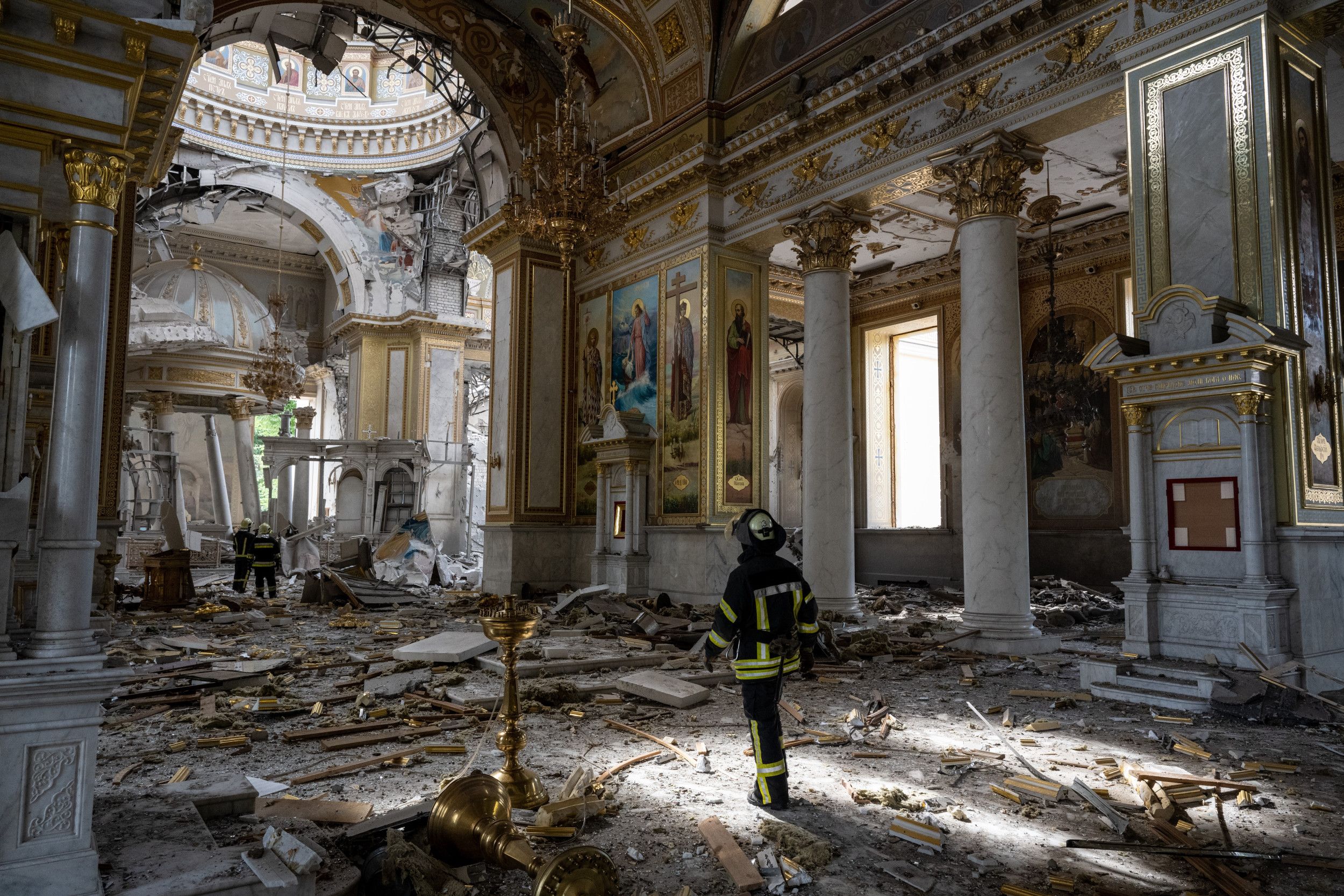Russian Missile Strike on Odesa Cathedral Leaves Ukraine With Stark Choices
At shortly after 2 a.m. local time on Sunday, a Russian precision-guided anti-ship Onyx missile struck the Orthodox Christian Transfiguration Cathedral in the center of Odesa, Ukraine. In a stark departure from the template of past Russian air attacks, this drone and missile barrage took direct aim at several key elements of the city's cultural heritage.
In one night alone, at least three strikes in and around Odesa's UNESCO-protected city center caused damage to approximately 25 historic buildings. While the following several days saw Russian forces return to targeting coastal transportation infrastructure—including a Danube River port just 200 meters from the Romanian border—Odesa's citizens and officials alike fear that Sunday morning's barrage could signal a turn in Russia's plans for their city.
"None of the previous attacks on Odesa were this large, and all of them had been focused mainly on objects outside of the city center: the airport, seaport facilities, warehouses, electricity substations, oil depots, and grain storage terminals," Odesa city council member Petro Obukhov told Newsweek.
"We got so used to our air defenses shooting down all of the drones and missiles threatening the city that it became almost like a show," he added.
However, in the days following Russia's July 17 withdrawal from the Black Sea Grain Initiative, a UN-brokered agreement that had allowed for Ukraine to safely ship agricultural exports from seaports in and around Odesa, Russia rapidly changed its tactics, leading to a series of strikes that destroyed at least 60,000 tons of grain throughout the region in less than a week.
Ukrainian firemen examine the damage after a Russian missile struck the historic Orthodox Holy Transfiguration (Spaso-Preobrazhensky) Cathedral on July 23, 2023 in central Odesa, Ukraine. The attack was part of an overnight barrage of 19 Russian rockets and missiles fired on the Black Sea port city and surrounding region, the fifth such wave of Russian strikes in a week that had previously targeted port and grain infrastructure, launched in an apparent bid to prevent Ukraine from exporting grain after Russia elected not to renew an extension of a grain export arrangement brokered last year by the United Nations and Turkey. Scott Peterson/Getty Images
"All of a sudden, the Russians started firing large quantities of Kh-22, Onyx, and Iskander-M missiles, and our air defenses have not had an answer for them," Obukhov explained. "For the first time since the early months of the war, I am spending time in the bomb shelter."
Despite the frightening turn of events, the human toll in Odesa thus far has been far less than that of notable Russian attacks in other cities earlier on in its full-scale war, as the following summary of some notable previous attacks reveals, based on details of the strikes released by the Ukraine government:
April 8, 2022: Several Russian Tochka-U missiles armed with cluster munitions kill 63 people and wound at least 150 at the main station in Kramatorsk
On June 27, 2022: Two Russian Kh-22 missiles struck a shopping center in Kremenchuk, killing 21 and injuring 59.
July 14, 2022: In Vinnytsia, three Russian Kalibr missiles killed 28 people and wounded 202 in the city center.
August 17-18: A series of missile strikes in Kharkiv killed 25 and injured 44.
October 11, 2022: At least 23 people were killed nationwide, including seven in the capital city of Kyiv, in a series of Russian attacks.
January 14, 2023: In the city of Dnipro, at least 46 were killed and 80 injured by a Russian Kh-22 strike on an apartment block.
Additionally, from April through October 2022, the city of Mykolaiv was subjected to a nearly nightly barrage of S-300 missile attacks, resulting in an almost daily deaths and injuries. And since its liberation from Russian occupying forces last November, the city of Kherson has been subject to a relentless bombardment of Russian artillery shells fired from just across the Dnieper River, with a May 3, 2023 strike alone killing more than 20 residents.
In comparison, one death and approximately 20 injuries were reported on Sunday following Russia's nighttime attack on central Odesa.
Russia's Presidential Administration did not respond to Newsweek's request for comment.
Members of Odesa's local security services keep watch over the damaged Transfiguration Cathedral in the center of the city on July 25, 2023. Sunday morning's attack was the first that appears to be specifically aimed at damaging objects of the city's cultural heritage. MICHAEL WASIURA/NEWSWEEK
Still, the city remains vulnerable to exactly the type of attacks that Russia has unleashed elsewhere in the country. Despite the provision of sophisticated air defense systems, including the American-made Patriot and the Franco-Italian SAMP/T, Ukraine still lacks a sufficient quantity of these assets to ensure that every potential target is protected.
"Our Western partners have done a lot to help," Ukrainian Lieutenant Colonel Serhii Sudets said in response to a question from Newsweek at the Ukraine Media Center in Odesa on July 25. "However, at the moment, we simply do not enough Patriots to allow for even a single battery to be deployed to the Odesa region."
On July 23, only a few hours after the strike that damaged the Transfiguration Cathedral, the Russian Ministry of Defense released a statement that offered a very different view of the attack.
"The most likely reason for its destruction was the fall of a Ukrainian anti-aircraft guided missile as a result of the incompetent actions of the operators of air defense systems, which the Armed Forces of Ukraine deliberately place in residential areas, including in the city of Odessa," the statement read.
Following the July 25 briefing at the Odesa Media Center, Ukrainian Lieutenant Colonel Sudets responded to the Russian accusation.
"We have a large open area over the sea, and so all launches from our major air defense systems are sent in that direction, towards Crimea," Sudets explained. "The Cathedral is located in the opposite direction, and it is simply not possible that an air defense rocket was sent towards it."
Businesses on Odesa's Preobrazhenska Street are seen open on July 25 in the wake of a Russian Onyx anti-ship missile strike on the Transfiguration Cathedral across the street. The blast was strong enough to break several windows in neighboring buildings, including those of a "Sushi Story" chain restaurant location. MICHAEL WASIURA/NEWSWEEK
When asked whether the Russian Onyx missile that crashed through the roof of the Cathedral might have landed there by mistake, Sudets was skeptical. The Cathedral itself is located at the edge of a large square that sits nearly two miles away from any potential target contained within the seaport.
"Russian missiles are not so inaccurate as to allow for such a possibility," he said. "If they had missed by 100 meters, that might have been understandable, but there is no legitimate target within 100 meters of the Cathedral. The Russians sent a missile into the center of Odesa because they intended to send a missile into the center of Odesa."
Another explanation offered by Kremlin-backed figures involved the narrative that a Russian missile would have done more damage to the Cathedral than what was visible following the July 23 strike.
"It is clear that if this had been a Russian Kalibr or Onyx, our precision-guided weapons, then the building would not have survived," Russian Channel One news anchor Alyona Lapshina said during a Sunday morning news broadcast.
A Western military expert strongly disagreed.
"The damage we see is perfectly consistent with an Onyx," Marcel Plichta, a former analyst with the U.S. Department of Defense, told Newsweek. "Cathedrals are not made out of papier-mache. One 300 kilogram warhead isn't going to completely obliterate a large stone structure that's been constructed to last for hundreds of years."
"The damage it did do was fairly significant," he said, "but if the Russians think it should have done more, I guess they're entitled to their opinion."
Still, the threat of further strikes, should Russian forces decide to carry them out, hangs over the city.
"The Russians have been striking non-cathedrals around Odesa, and they've been doing it pretty accurately," Plichta said. "They seem to be hitting what they want to hit."
Unless Ukraine receives additional Patriot or SAMP/T batteries from its Western partners in the immediate future, its military planners may soon be faced with a very difficult choice.
"Odesa doesn't have the same level of sophistication in its air defenses that Kyiv does," Plichta explained. "But if these attacks continue, maybe Ukraine will decide that moving a Patriot system to the south is worth leaving the capital more vulnerable."
"That might even be exactly what the Russians hope they'll do," he cautioned.
Source: Newsweek


